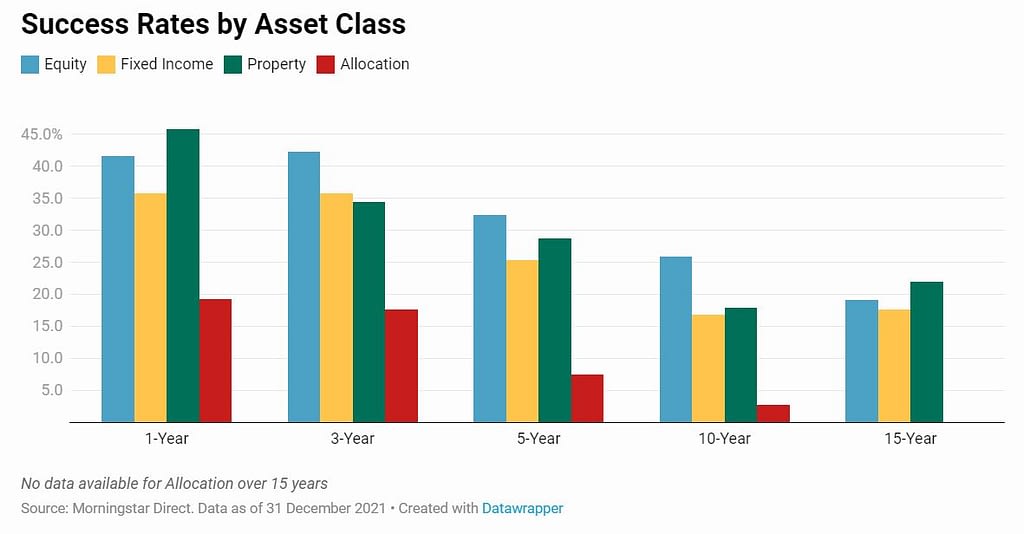Active or passive: which funds are best? This is a common debate seen in the world of investing and is often divided into those that favour one or the other. Realistically, both methods have their merits, depending on the scenario and needs of the investor. Understanding where the advantages lie for each style can help maximise the potential of a portfolio.
-
Active vs. Passive
-
What is passive investing?
-
What is active investing?
Active vs. Passive
- Active is a more “hands-on” approach, whereby more buying and selling takes place; many investors will put their faith in a fund manager who “actively” seeks to beat the market and seek higher returns.
- Passive is a more “hands-off” approach, involving less buying and selling; this style may be more akin to buy-and-hold, whereby investors often use index or mutual funds.
- Historically, passive has outperformed active investing over the long run, except in certain areas.
Active investing has been viewed as a method to generate higher profits for investors, against simply trying to match the returns of the market in general – as compared to the achievements of passive investing. However, historically it shows that passive investments have taken in larger amounts of investment flow and achieved greater returns. That said, active investing has shown to be useful in times of market turbulence or certain areas, with the right strategy in place.
Passive Investing
Passive investments are suited for the medium- to long-term game in a cost-effective manner, owing to the limiting of buying and selling and adopting a buy-and-hold approach. Instead of anticipating market movements and trying to navigate around them, the investor holds through the ups and downs with little interference. This takes patience and confidence in the strategy, yet over the long term, the markets generally produce more positive returns than negative.
Index funds have become hugely popular with passive investors and may make up the core holding of their portfolios. For example, large volumes of investments follow the S&P 500 index, owing to its popularity and companies that are included in the index; participating in the profits of these favours the long-term investor by aligning with the upward trend of its trajectory, even after downturns.
Passive investing has gained popularity in large part due to its low fees, seeing as no one is “picking” stocks and instead follows a benchmark index (S&P 500, Dow Jones etc.); coupling this with a buy-and-hold strategy, investing in this manner is very cost-effective – generally, around 0.20% versus 1.35% for active investing. It is also clear what exactly is in an index fund and easily adds diversification to a portfolio, as well as keeping the investor disciplined from their own buying and selling mistakes – this is often what leads to investors making bad decisions to their portfolios when actively trying to manage their investments.
Passive investing has its limitations, which – whilst not inherently detrimental – may not suit every investor. For example, they are often limited to the set of investments of the index they track, with no flexibility no matter what happens in the markets. The returns are also tied to the markets in which they are tracking, which means they don’t aim to “beat” the market, rather mimic their returns; at the same time, they will fall with market downturns rather than be shielded from it. On the other hand, active investing aims to beat the market and chase bigger returns, and management can help navigate periods of market lows to result in fewer losses.
Active Investing
Active investors aim to “beat” the returns of the market, rather than roughly match it, as can be achieved by a passive approach. In doing so, the management of a portfolio takes a deeper look at the intricacies of assets and the market, to take advantage of fluctuations and yield greater returns. This analysis often results in more buying and selling to move in and out of assets, in an attempt to read changes in the market and make greater profits in the process.
Assets that are actively managed are usually overseen by a manager and a team of analysts who crunch both quantitative and qualitative data, to make decisions on investments and aim to “exploit” the market for greater profits. Due to this higher level of involvement, the costs of active management are greater than their passive counterpart. Although historical data favours passive investments over the long run, there are benefits that may suit certain investors.
A significant benefit of using management is the ability to manage risk under market volatility. Whereas passive investments will follow the ups and downs of the market, active investors are able to shift their positions to avert taking too great a loss (such as during the 2008 financial crisis).
Active investing is, naturally, suited to day or short-term trading, but these short-term opportunities can be taken advantage of as part of a long-term strategy, to boost the overall returns. The greater involvement can also be used for more tailored approaches to a portfolio, especially when a client does not want to simply match the market or a benchmark, but something more specific.
As for its limitations, we already know that it’s costlier than passive investing, but further to that are minimum requirements for many active assets to be invested in; these obstacles make investing harder for the newer/younger investors and a reason many people flock to passive instruments. And whilst active managers are supposed to manage risk, they can actually have negative consequences if their decisions are wrong and returns are negatively affected. Unfortunately, many simply struggle to outperform the market.
Making The Choice
It is prudent to review historical data when analysing investments and make informed decisions for a portfolio going forward, otherwise, you risk blindly speculating and relying on a “crystal ball” approach. When this comes to active versus passive, it’s hard to ignore that the data largely shows passive trumping active investments over the long term.
Morningstar’s recent report looked at actives versus their passive peers, covering about 75% of the fund market, and found that passives still reign strong:

Their conclusion is to focus on fees over the long term and to highlight where active investing may work for you.
* * *
We don’t know what the markets will do in the future; discounting one method for the other could be unwise, despite what we may perceive to be the best route. The key takeaway is to understand each method and how they could both work for your portfolio.
Need some financial advice? I’m here to help!
If you have any questions, are seeking wealth management, or just a chat — drop me an email at:


